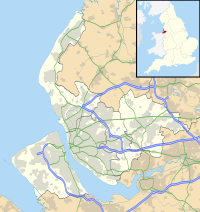Ullet Road Unitarian Church
| Ullet Road Unitarian Church | |
|---|---|

Ullet Road Unitarian Church
|
|
| Coordinates: 53°23′23″N 2°56′17″W / 53.3898°N 2.9381°W | |
| OS grid reference | SJ 377 885 |
| Location | 57 Ullet Road, Sefton Park, Liverpool, Merseyside |
| Country | England |
| Denomination | Unitarian |
| Website | Ullet Road Unitarian Church |
| Architecture | |
| Functional status | Active |
| Heritage designation | Grade I |
| Designated | 14 March 1975 |
| Architect(s) |
Thomas and Percy Worthington |
| Architectural type | Church |
| Style | Gothic Revival |
| Groundbreaking | 1896 |
| Completed | 1899 |
| Specifications | |
| Materials | Red brick exterior Sandstone interior Slate roofs |
| Clergy | |
| Minister(s) | Philip Waldron |
Ullet Road Church is a Unitarian church at 57 Ullet Road, Sefton Park, Liverpool. Both the church and its attached hall are separately recorded in the National Heritage List for England as designated Grade I listed buildings. It was the first place of worship in the United Kingdom to register a civil partnership for a same-sex couple. It is a member of the General Assembly of Unitarian and Free Christian Churches, the umbrella organisation for British Unitarians.
The predecessors of the congregation now worshipping in Ullet Road originated from a group of Presbyterians during the later part of the 17th century, that is, in the immediate aftermath of the English Civil War. They originally gathered in a meeting house in Castle Hey, and in 1727 moved to a new chapel in Benn's Gardens. In 1811 they moved to another new chapel in Renshaw Street, and by this time had become Unitarians, as many English Presbyterians did. Despite some opposition, in 1894 the congregation decided to move to what was then a suburb of Liverpool. The architects Thomas and Percy Worthington, Unitarians from Manchester, were commissioned to design the church and associated buildings. The church opened in June 1899, followed by the hall and other associated buildings in 1902.
...
Wikipedia

